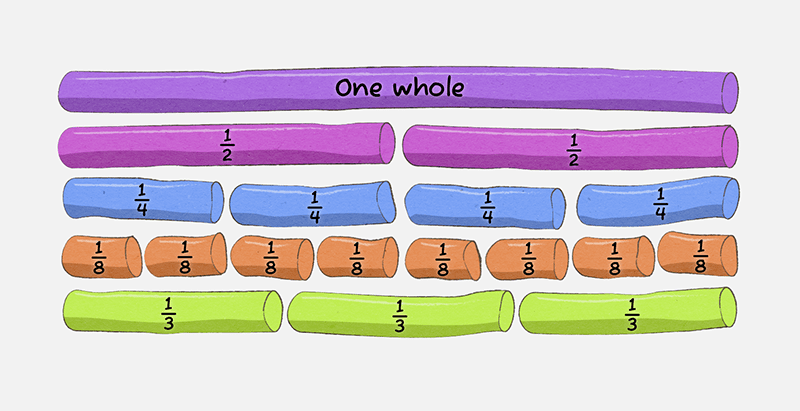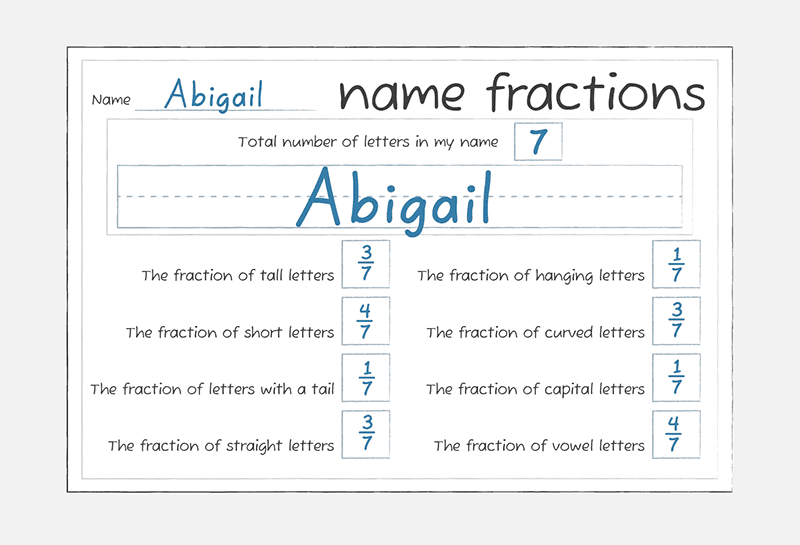Back to library
Maths at home: Fractions
As with all new skills, learning fractions takes practice. Just including your child when fractions come up during the day is valuable practice and helps them see how fractions are relevant. You may also like to try one of the simple, fun activities provided.
Everyday routines
One of the easiest ways to help your child improve their fraction skills is to include them when you are using fractions yourself. Fractions come up throughout our days, and it can be as simple as just talking about them with your child. For example, asking if they would like their sandwich cut into halves or quarters, or telling them ‘we will leave for school in ¾ of an hour’ or ‘we are a third of the way to the swimming pool’.
Cooking
Cooking is a great everyday activity that uses fractions, and there is a tasty reward at the end! Recipes often require partial units of ingredients, such as ½ teaspoon of cinnamon or ⅓ cup of milk. Show your child the fractional amount on the measuring cup and read it out as you are measuring. Older children may be able to read the amount themselves and even help measure out the ingredients.

Games and activities
Years F–2
Playdough fractions

You will need:
-
playdough
-
a kid’s (or plastic) knife.
This activity uses playdough to make a fraction wall, starting with a 'whole’ and cutting up the pieces to make equal parts. Ask your child to:
-
Roll out five playdough logs that are the same length.
Discussion points: How did they decide these were the same length? What makes them look the same? For example, they line up with each other, they start and end in the same place.
This helps children compare and see that they are ‘equal’ before they start cutting the whole logs into parts. -
Choose one log and put it at the top of the table. This will be the ‘whole’ in your fraction wall.
-
Take a second log and cut it into two equal halves (you may want to fold it in half to find the middle point to help make sure the parts are equal). Place these parts underneath the ‘whole’ log as shown.
Discussion points: What name would we give these parts? See if they can name these as halves before you tell them. How many halves make a whole? -
Try cutting the third log into equal halves, then cut each of these halves into half again (to end up with four equal parts, or quarters). Line these parts up under the halves on your fraction wall.
Discussion points: What name would we give these parts? See if they can name these as quarters before you tell them. Compare the fractions you have so far. How many quarters make a half? How many quarters make a whole? -
Cut the fourth log into halves, then cut each half into halves again (quarters), then halve each of the quarters again to make eighths. They are cutting each piece exactly in half to make ‘equal parts’. Line these parts up under the quarters row.
Discussion points: What name would we give these parts? See if they can name these as eighths before you tell them. Compare the fractions you have again. How many eighths make a quarter, half or whole? During the activity encourage your child to practice saying the words for the fractions (half, quarter, eighth) and counting out the parts (one half, two halves). This helps familiarise them with the language of maths and makes them more comfortable hearing and using it. -
You can extend the fraction wall further, by using the fifth log and halving pieces as in the previous steps until you create sixteenths, or you can mash up the playdough and repeat the process to reinforce the ideas.
For an extra challenge, ask your child to have a go at cutting the final log into three equal parts. What do they notice? For example, some children will notice that it is harder to make the parts equal when we are not halving the pieces. It may help to work through a process to make the pieces even, such as by putting the pieces side-by-side to compare them directly, and taking small bits from the largest piece to add to the smaller pieces until they are all equal.
Toy or object sort
You will need some toys or household items. You will need an even number for this activity.
Ask your child to:
- collect a big group of toys (dolls, animals, cars, blocks or crayons) or other household items (cutlery, plastic containers, pegs). Make sure you have an even number and put back any extras.
- sort the items into groups of ½, ¼ and ⅛.
Years 3–4
Closest to one card game

You will need:
- a deck of cards with the face cards removed
- two or more players.
To play:
- Deal the cards out evenly to all players.
- Each player turns over the top two cards and places one over the other to make a fraction. Players must decide which card they want to use as the numerator (top number) and denominator (bottom number) to get their fraction closest to one.
- Players compare their fractions, and the player with the closest fraction to one wins the cards that have been played. If multiple players are equally close to one, they share the played cards equally (another fraction to talk about!).
- Whoever has the most cards when all the cards have been played wins.
For an extra challenge, play a version where you try to get the closest fraction to ½.
What’s in a name – fractions

You will need a pen and paper.
This collaborative activity can be done solo or with as many people as you like.
- Each person writes their name down on a piece of paper. This can be first name, last name, nicknames or other family members’ names.
- Count the number of letters in the name. This becomes the denominator (bottom number) when working out the following fractions:
● the fraction of capital letters
● the fraction of vowels
● the fraction of consonants
● the fraction of letters with dots
● the fraction of tall letters
● the fraction of hanging letters
● the fraction of letters with curves
● the fraction of short letters. - If you want to build on this you could work together to compare everyone’s fractions. For example, who has the largest fraction of consonants in their name? Who has the smallest fraction of tall letters? You may also like to compare the fractions of vowels in everyone’s names and put them in order from smallest to largest.
For an extra challenge you can also play it backwards: ask your child to work out the name of a family member based on fraction clues you give them. For example, choose a family name like Nanna, and tell your child that you’re thinking of a name that has ⅕ capital letters, ⅗ consonants and ⅖ vowels. Ask your child to write out different family names as fractions, to work out the right name.
